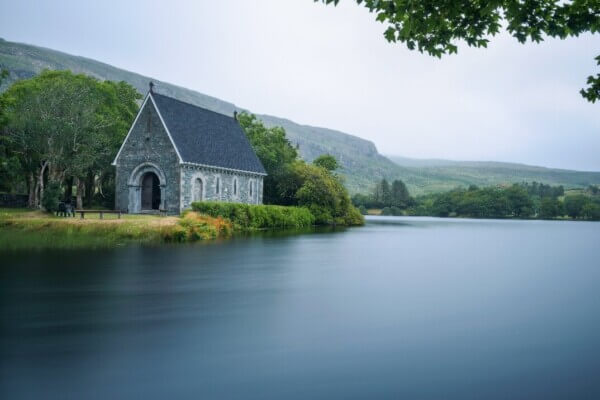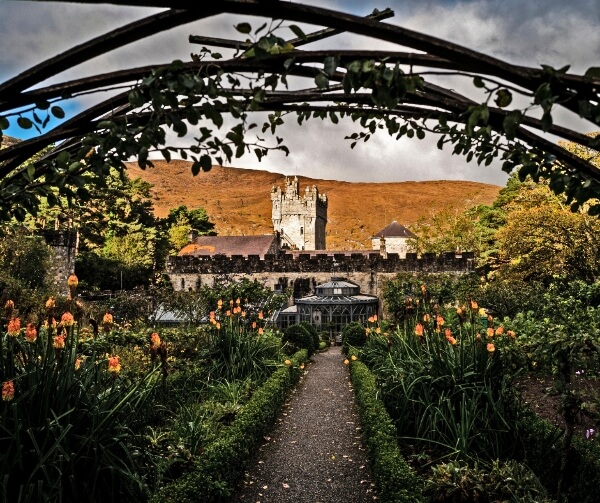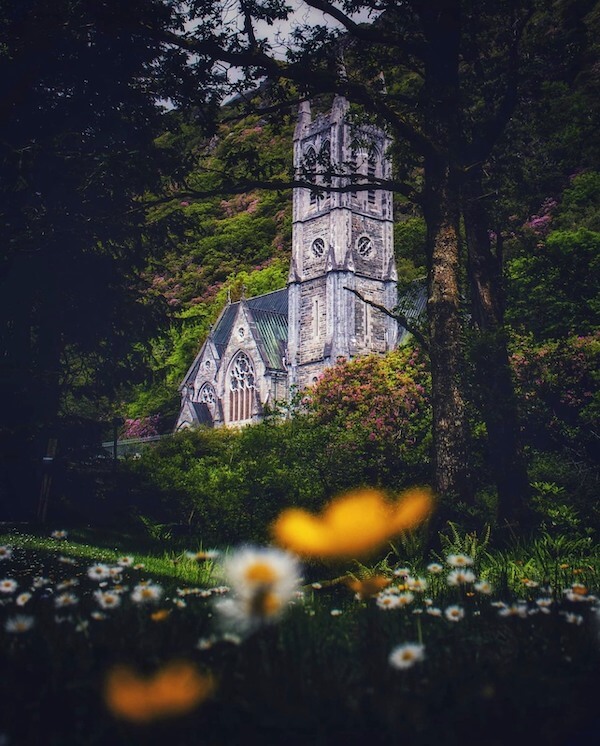Who needs a visit to New England when you can see an explosion of colors in Ireland during the autumn months?
 This post and page contain affiliate links and I may earn compensation when you click on the links at no additional cost to you.
This post and page contain affiliate links and I may earn compensation when you click on the links at no additional cost to you.
Autumn in Ireland officially begins on Sept. 1st and ends on Nov. 30th.
Those of us who live in the United States eagerly await the annual change of colors that can be experienced across the country but is perhaps most prevalent in the northeast, particularly Vermont.
While Ireland has only about 11 percent forest compared to the average 40 percent across mainland Europe, there are still plenty of places to enjoy the brilliant red and gold autumnal splendor.
Here are 10 places to enjoy the fall foliage in Ireland.
Dún a Rí Forest Park
Formerly known as the Cabra Estate, the Dún a Rí Forest Park in County Cavan is the perfect place to visit during the autumn months when it comes alive with bright yellows and reds.
In addition to its natural beauty and vibrancy — and maybe because of it — this area is steeped in folklore and history.

Legend tells us that Cuchulain, the great Fianna warrior camped in the park while conducting a single-handed defense of Ulster against the armies of Queen Maeve of Connacht.
The Normans also made their mark in Dun a Ri, building a stronghold that is known as Fleming’s Castle.
You’ll find four walks in the park that are between 1.5 and 2 kilometers in length.
In addition to the sweep of autumn colors that is evident during this time of year, there are quite a few attractions to keep an eye out for.

They include the Dún a Rí Ice House, the Toba na Splinne Holy Well, Cromwell’s Bridge, an old military barracks that was once used by the Red Coats (British soldiers) and is said to be haunted, as well as Sara’s Bridge.
There are several cool sculptures throughout the park.
They include a series of frog sculptures, in addition to the Badger, Fox, Hare, Pine Marten, and Otter sculptures, which make this a very interesting place to explore any time of year.
How to Get There: Take the R179 from the center of Kingscourt and drive approximately 2 km (1.24 miles) to the forest park entrance. Kingscourt is about 1 hour and 18 minutes from Dublin on the N2.
Killarney National Park
You can find mountains, lakes, woods, and waterfalls, all in a 26,000-acre expanse known as Killarney National Park.
The park, a UNESCO Biosphere Reserve, contains several native oak and yew woodlands as well as evergreen trees, shrubs, and lichens that are well suited to the local climate.

In fact, Killarney National Park has the largest stretch of native woodland remaining in Ireland and is indicative of how the country might have looked thousands of years ago before deforestation.
In the autumn light, the woodlands are spectacular.
Look out for the red deer (believed to have had a presence here since the Ice Age) as well as the Silka deer, introduced to Ireland from Japan in 1865.
Muckross House & Gardens is a popular attraction that is located within the park.
Take a guided tour of the 19th-century Victorian mansion, where Queen Victoria stayed in 1861.

It is full of historical paintings and artifacts of interest. Be sure to also visit the Muckross Traditional Farms, where you’ll see the many farming practices that were common in rural Ireland during the 1930s and ‘40s.
To fully appreciate the autumn colors, why not take a horse and trap ride through the park and experience the fall colors in all their splendid glory?
How to Get There: if you’re already in Killarney, you can’t miss signs for the park. From Dublin, the journey to Killarney is about 3 hours and 25 minutes. Take the M7 from Dublin to Limerick and then the N21 to Killarney.
Gougane Barra National Forest Park
This was Ireland’s first national park, which opened in 1966.
Gougane Barra National Park, located in County Cork, includes approximately 350 acres of cultivated and natural forestry.

The entire park is about 1,000 acres in size and is particularly beautiful during the autumn.
A popular tourist attraction in this region is the small church that sits on a tiny island at the edge of Gougane Barra Lake.

It is where St. Finbarr, patron saint of Cork, established a monastery in the 6th century.
There are six walking trails in the park, suitable for all levels of fitness, ranging from 0.5 kilometers to 2.5 km in length.
How to Get There: From Cork City take the N22 and then the R584. The journey takes about an hour.
Save on Wifi in Ireland with WiFi Candy – take 10% off with code IOB2024
Glendalough
This ancient monastery that St. Kevin founded in the 6th century is absolutely stunning during the autumn months.

Three centuries later, it had rivaled Clonmacnoise in importance, with scholars from all across the country and the world coming to study here.
The hundreds-year-old broad-leaved, deciduous trees turn a beautiful gold here that is reflected in the Glendalough lakes.
The Glendalough monastic site, which is part of the Wicklow National Park, includes a near-perfect round tower, St. Kevin’s Kitchen (actually a church), St. Kevin’s Cell (a beehive hut where Kevin lived), St. Kevin’s Cross, and more.

A visitor center complete with interactive displays tells the story of St. Kevin’s journey to Glendalough and how he created this important religious site.
After you’ve explored the ruins of the monastery, be sure to take a walk on any one of the trails and walks that traverse this region.

They include the Miners’ Road Walk (Purple Route); the Poulanass and St. Kevin’s Cell (Bronze Route); the Green Road Walk (Green Route); the Derrybawn Woodland Trail (Orange Route); the Woodland Route (Silver Route); the Spinc and Glenealo Valley route (White Route); the Sinc and the Wicklow Way (Red Route), and the shorter Spinc route (Blue Route).
How to Get There: Take the M50 from Dublin and then the R755. The journey takes about an hour.
Kilruddery Gardens
Kilruddery Gardens, also in County Wicklow, is just 30 minutes south of Dublin.

Its 800-acre estate is a popular bio-diverse farm that includes flowering woodland, 17th-century gardens (inspired by the gardens of Versailles), cut flower gardens, a variety of high-hedged pathways, a natural amphitheater, and more.
The estate was founded by the fourth and sixth Earls of Meath. It is currently managed by the 11th Earl of Meath, Anthony Jacques Brabazon.
Guided tours of the house are available from May through September and at weekends during the month of October.
A farmer’s market takes place every Saturday in the estate’s Horse Yard and Grain Store from 10 a.m. to 3 p.m. featuring a range of local produce and crafts.
How to Get There: Take the M50 from Dublin, then the N11 and get off at Exit 7 for Bray/Greystones. You can also reach the estate by way of the Dart. From the train station, take the 184 or 84 bus to the gates of the estate.
Glenveagh Castle Gardens
Nestled below Mount Errigal in County Donegal’s Glenveagh National Park is Glenveagh Castle.

The Victorian castle estate includes a 27-acre garden that is known for its large collection of trees and shrubs.
The gardens, with their original Victorian layout still intact, are regarded as one of Ireland’s outstanding horticultural masterpieces.
The castle belonged to John George Adair and his wife Cornelia.
Its construction began the year after their marriage in 1869 and in the mid-1880s, the gardens were developed.
While the Walled Garden is a vibrant mix of colors during the summer months, it turns a dramatic red and gold beginning in October, as do the surrounding woodlands.
Access to the park, including the gardens, is by shuttle bus only. It is free to visit.
How to Get There: From Letterkenny, take the N56 to the R255. The journey should take about 20 minutes by car.
Blarney Castle
Many visitors to Ireland miss out on the autumnal beauty of Blarney Castle because so many of them visit during the summer months.

However, autumn is a great time to visit this iconic 15th-century iconic attraction in County Cork that is bathed in bright gold, vivid reds, yellows, and endless shades of orange and brown.
Needless to say, the beautiful parkland and gardens around the castle are worth exploring.
Some of the trees in the park are more than 100 years old.
Planting began in the 1800s, with more added on over the years by the horticulturist Sir Harold Hillier.
Some of the estate’s features include the beautiful fern garden, the Himalayan walk as well as Blarney’s Irish Garden.
How to Get There: From Cork take the N20. The journey should take about 15 minutes.
Kylemore Abbey
In the middle of Connemara, you’ll find the beautiful Kylemore Abbey, a former boarding school that is now a popular tourist attraction.
October and November are great months to explore this part of County Galway.

The landscape goes from the familiar greens of summer to the rich golden hews of autumn.
Like other parts of Ireland, the Kylemore Abbey site was once covered in a large oak forest.
When Mitchell Henry decided to build a castle there, he also planted over 300,000 trees, transforming it from a boggy landscape to rich woodland.
Today, that woodland surrounds Kylemore Abbey and in the autumn it is awash in beautiful fall colors.
Be sure to take a walk around the property to really appreciate this special time of year.

The story of Kylemore began with Henry who bought what was once a hunting lodge for his wife, Margaret Vaughan Henry, transforming it into the 70-room house that it is today.
Be sure to tour the house during your visit to Kylemore Abbey as well as its Walled Garden and nearby Neo-Gothic church, and enjoy the fall foliage while walking on the estate’s many woodland trails.
How to Get There: From Galway City, take the N84. The journey will take about 1 hour and 30 minutes.
Explore Ireland on the 9-Day Irish Discovery Tour with Tourradar
Mount Stewart
Autumn is a great time to visit Mount Stewart, a neo-classical house located on the eastern shore of Strangford Lough in County Down.
The estate’s landscaped gardens are awash in autumn colors.

When you visit, be sure to walk the more than 5 ½ miles of beautiful walking trails, where you’ll discover a rich landscape of farmland, woodland, monuments, and other buildings.
Guided tours of the house are available. See over 2,500 historic artifacts, famous works of art, and memorabilia related to the Stewart family.

The house also includes a chapel with stained glass, along with 22 sets of chairs that were used during the Congress of Vienna, a political event that decided the fate of Europe after Napoleon’s surrender.
How to Get There: From Belfast, take the A2 and A20. The journey should take about 25 minutes.
Go on an Aer Lingus Package Vacation to Ireland
Carton Estate
Carton House, now a hotel, together with its surrounding estate, was once the ancestral seat of the Earls of Kildare and the Dukes of Leinster. It is located about 23 km (14 miles) west of Dublin in Maynooth, Co. Kildare.

The estate is one of Ireland’s finest Georgian-style parklands. It is now a luxury hotel with two golf courses.
The house has a storied history, including the fact that the Fitzgeralds, who were the family who had owned the estate since the 12th century, lost it all in the 1920s when the third son of the 6th duke sold his birthright to pay off a huge gambling debt.
Before it was turned into a hotel, Carton House was a popular location for filmmakers.
Some of the movies filmed here include Stanley Kubrick’s “Barry Lyndon,” “The Big Red One” and “Leap Year.”
Queen Victoria, Princess Grace, and Prince Rainier all stayed at Carton House.

Lady Emily Fitzgerald was responsible for developing the estate, which is now a Special Area of Conservation. It is home to a wide variety of animals, including red deer.
Even if you’re not staying at the hotel, you can still experience the beautiful grounds of the Carton Estate that are well worth seeing during the autumn season.
Take the Carton House trail, a 2-mile looped walk that starts and ends in nearby Maynooth.

On the grounds, you’ll discover the Tyrconnell Tower, intended as a mausoleum for Richard Talbot, the 1st Earl of Tyrconnell as well as Shells Cottage decorated inside and out with seashells.
How to Get There: Take the N4 and then the R148 to Maynooth. You can also take a train or bus from Dublin. The journey by car takes about 30 minutes and by public transportation, expect it to take close to an hour.
Have you experienced the fall foliage in Ireland? If so, let me know what places you visited.





